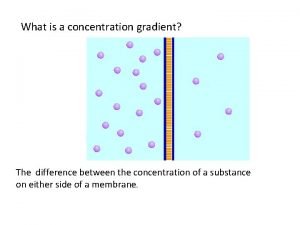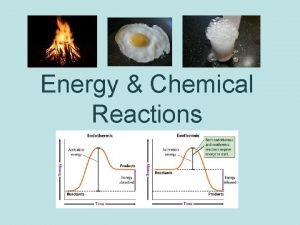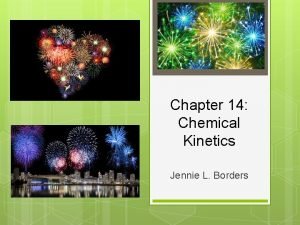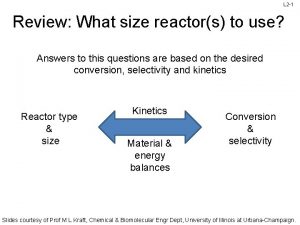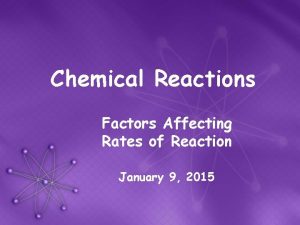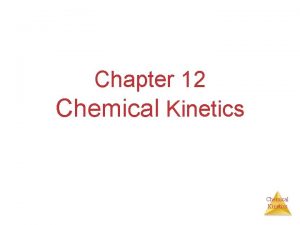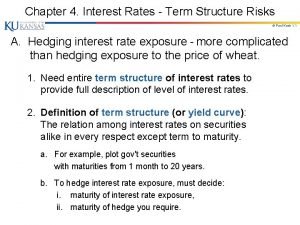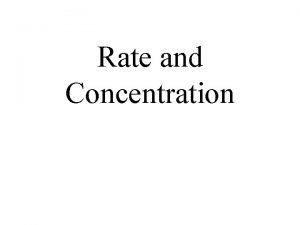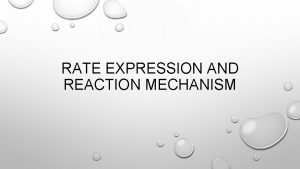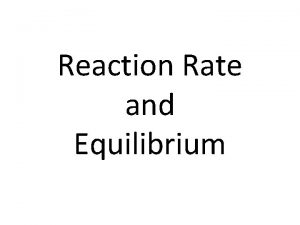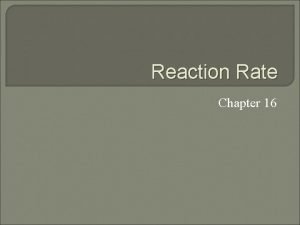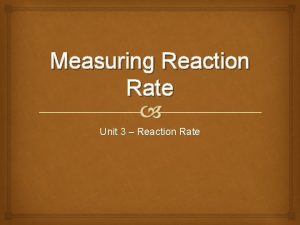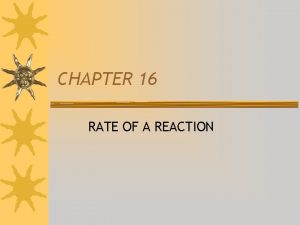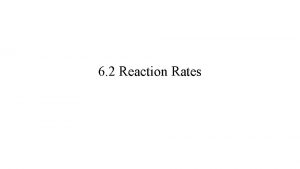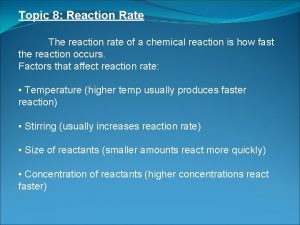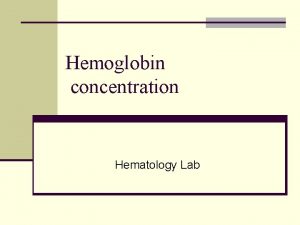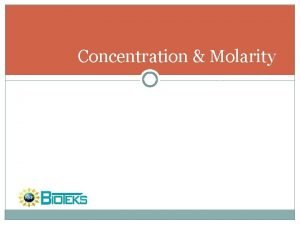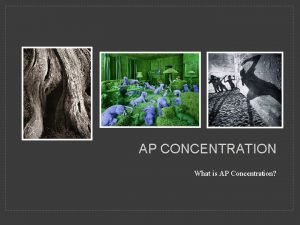11 2 Reaction Rate and Concentration YOU ARE







![Example 11. 1 • CH 3 CHO(g) CH 4(g) + CO(g) [ ] 0. Example 11. 1 • CH 3 CHO(g) CH 4(g) + CO(g) [ ] 0.](https://slidetodoc.com/presentation_image_h2/42767abae1e8ef2adc5bc77c7183de98/image-8.jpg)
![Calculate the Rate Constant • Rate = k[CH 3 CHO]2 • Choose one set Calculate the Rate Constant • Rate = k[CH 3 CHO]2 • Choose one set](https://slidetodoc.com/presentation_image_h2/42767abae1e8ef2adc5bc77c7183de98/image-9.jpg)



![Why Use a Logarithm? • If rate = k[A]m • Then ln rate = Why Use a Logarithm? • If rate = k[A]m • Then ln rate =](https://slidetodoc.com/presentation_image_h2/42767abae1e8ef2adc5bc77c7183de98/image-13.jpg)

- Slides: 14

11. 2 Reaction Rate and Concentration YOU ARE EXPECTED TO BE ABLE TO: • Define the initial rate of a reaction as the instantaneous rate at the start of the reaction. • Write a rate law expression for a given reaction given experimental results that show the variation of initial rate with concentration. • Define the concept of order of reaction and determine the order of a given reaction from initial rate vs concentration data Chemistry 1011 Slot 5 1

Initial Rate of Reaction • The initial rate of reaction is the instantaneous rate measured at the start of the reaction • The initial rate can be used as a benchmark • Measurements of the initial rate for a reaction at different starting concentrations can be used to determine the effect of concentration on rate Chemistry 1011 Slot 5 2

The Rate Expression or Rate Law • In general: – Reactions occur as a result of collisions – The higher the concentration of molecules, the greater the rate • In some reactions, the rate is directly proportional to the concentration • In other cases, the rate may increase much more quickly than the concentration • The relationship between rate and concentration is known at the rate law or rate expression Chemistry 1011 Slot 5 3

Determining the Rate Law Expression • The rate law MUST be determined from experiment – it is not related to the stoichiometry of the equation for the reaction • Examine the concentration vs time graph for N 2 O 5 – Determine instantaneous rates at different times and concentrations of N 2 O 5 – Plot instantaneous rate vs [N 2 O 5 ] – This is a straight line, (equation y = mx + b) • Rate = k[N 2 O 5] ; this is the rate law expression; k is the rate constant Chemistry 1011 Slot 5 4

Using Initial Rates to determine the rate Law • Measurements of the initial rate of reaction at different initial concentrations can be used to determine the rate law expression • If a graph of initial concentration vs initial rate is a straight line, then rate is directly proportional to concentration: rate = k [reactant] • If a graph is a curve, then rate = k[reactant]m Chemistry 1011 Slot 5 5

Order of Reaction • The rate law expression is of the form: Rate = k[A]m • The power to which the concentration is raised is called the order of reaction • If m = 0, then “zero order” • If m = 1, then “first order” • If m = 2, then “second order” Chemistry 1011 Slot 5 6

Calculating the Order of Reaction when there is One Reactant • If m is not equal to 1, the order of the reaction can be determined by comparing two rates at two different concentrations: • Rate 1 = k[A]1 m • Rate 2 = k[A]2 m Rate 1 = k[A]1 m = [A]1 m Rate 2 k[A]2 m [A]2 Chemistry 1011 Slot 5 7
![Example 11 1 CH 3 CHOg CH 4g COg 0 Example 11. 1 • CH 3 CHO(g) CH 4(g) + CO(g) [ ] 0.](https://slidetodoc.com/presentation_image_h2/42767abae1e8ef2adc5bc77c7183de98/image-8.jpg)
Example 11. 1 • CH 3 CHO(g) CH 4(g) + CO(g) [ ] 0. 10 M 0. 20 M 0. 30 M Rate (mol/L. s) 0. 085 0. 34 0. 76 • Choose the first two concentrations 0. 40 M 1. 4 Rate 2 = 0. 34 = 4. 0 Rate 1 0. 085 [CH 3 CHO]2 = 0. 20 = 2. 0 [CH 3 CHO]1 0. 10 4. 0 = (2. 0)m ; m = 2 Rate = k[CH 3 CHO]2 The reaction is second order Chemistry 1011 Slot 5 8
![Calculate the Rate Constant Rate kCH 3 CHO2 Choose one set Calculate the Rate Constant • Rate = k[CH 3 CHO]2 • Choose one set](https://slidetodoc.com/presentation_image_h2/42767abae1e8ef2adc5bc77c7183de98/image-9.jpg)
Calculate the Rate Constant • Rate = k[CH 3 CHO]2 • Choose one set of data 0. 085 mol/L. s = k x (0. 10 mol/L)2 k = 0. 085 mol/L. s = 8. 5 L/mol. s (0. 10 mol/L)2 Chemistry 1011 Slot 5 9

Order of Reaction with More Than One Reactant • Most reactions involve >1 reactant a. A + b. B products • General rate law expression is: rate = k[A]m x [B]n – m is “order with respect to A – n is order with respect to B – Overall order is m + n Chemistry 1011 Slot 5 10

Determining the Order • Hold concentration of one reactant constant and vary other - measure initial rate • Repeat, holding concentration of other reactant constant • See Example 11. 2, page 308 Chemistry 1011 Slot 5 11

Determining the Order of Reaction Graphically • As an alternative to calculating the order of reaction by comparing two pieces of data, a graphical process can be used • Plot rate vs concentration • If the result is a straight line, there is a first order reaction, slope = k • If the result is a curve, it is necessary to construct a graph of (natural) log rate vs (natural) log concentration to determine m Chemistry 1011 Slot 5 12
![Why Use a Logarithm If rate kAm Then ln rate Why Use a Logarithm? • If rate = k[A]m • Then ln rate =](https://slidetodoc.com/presentation_image_h2/42767abae1e8ef2adc5bc77c7183de98/image-13.jpg)
Why Use a Logarithm? • If rate = k[A]m • Then ln rate = ln k + m ln [a] • This will be a straight line with slope m Chemistry 1011 Slot 5 13

Zero Order Reactions • In rare cases, the rate of reaction is independent of the concentration of reactant(s) • In these cases – Rate = k[A]0 • A plot of rate vs [A] would be a horizontal straight line Chemistry 1011 Slot 5 14
 Antigentest åre
Antigentest åre Order of reaction
Order of reaction Whats a concentration gradient
Whats a concentration gradient Movement of high concentration to low concentration
Movement of high concentration to low concentration Concentration in chemical reaction
Concentration in chemical reaction Concentration in chemical reaction
Concentration in chemical reaction Vertical
Vertical Ictahedron
Ictahedron Activity formula
Activity formula What is catalyst and how it affects reaction rate
What is catalyst and how it affects reaction rate Reaction rate and stoichiometry
Reaction rate and stoichiometry What is real interest rate and nominal interest rate
What is real interest rate and nominal interest rate Plant growth definition
Plant growth definition Bond equivalent yield
Bond equivalent yield 1 year forward rate formula
1 year forward rate formula


